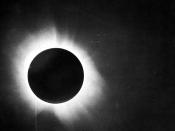The concept of a body so massive that not even light could escape it was put forward by the English geologist John Michell in a 1783 paper sent to the Royal Society. At that time, the Newtonian theory of gravity and the concept of escape velocity were well known. Michell computed that a body 500 times the radius of the Sun and of the same density would have, at its surface, an escape velocity equal to the speed of light, and therefore would be invisible. In his words:
If the semi-diameter of a sphere of the same density as the Sun were to exceed that of the Sun in the proportion of 500 to 1, a body falling from an infinite height towards it would have acquired at its surface greater velocity than that of light, and consequently supposing light to be attracted by the same force in proportion to its vis inertiae (inertial mass), with other bodies, all light emitted from such a body would be made to return towards it by its own proper gravity.
Although he thought it unlikely, Michell considered the possibility that many such objects that cannot be seen might be present in the cosmos.
In 1796, the French mathematician Pierre-Simon Laplace promoted the same idea in the first and second edition of his book Exposition du Systeme du Monde. It disappeared in later editions. The whole idea gained little attention in the 19th century, since light was thought to be a massless wave, not influenced by gravity.
In 1915, Einstein developed the theory of gravity called General Relativity. Earlier he had shown that gravity does influence light. A few months later, Karl Schwarzschild gave the solution for the gravitational field of a point mass, showing that something we now call a black hole could...



Citing
Great paper, but needs work cited. For college undergrad (As stated), this is a requirement.
1 out of 1 people found this comment useful.